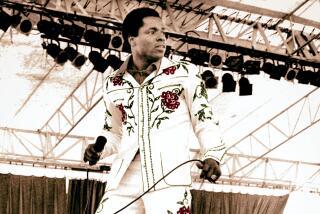JOE LIGGINS: A HONEY OF AN R&B; MAN
- Share via
Joe Liggins’ death July 31 in a Lynwood hospital closes another chapter in the first book of rock ‘n’ roll: a book written by pre-’50s black innovators like Louis Jordan (“Caldonia Boogie”), Roy Brown (“Good Rockin’ Tonight”) and Liggins, best known for “The Honeydripper.”
A Compton resident for the last 40 of his 72 years, Liggins was not just a major force in Los Angeles’ R&B; scene of the ‘40s, but he showed ‘80s audiences what it was all about by keeping the Honeydrippers active right up until his death. (The band plans to continue playing its scheduled dates.) When English rock singer Robert Plant recorded an R&B; mini-album in 1984, he acknowledged Liggins’ importance by dubbing his lineup of all-star musicians the Honeydrippers.
Born in Oklahoma and raised in San Diego, Liggins was strongly influenced by Duke Ellington. The pianist played in various bands in Los Angeles R&B; nightclubs and finally organized his own group, the Honeydrippers, in 1944.
Had Liggins chosen, he could have advanced the embryonic sound of rock ‘n’ roll by recording “The Honeydripper” several years earlier than its 1945 release date.
In an interview conducted almost a year ago, Liggins recalled working in San Diego and Los Angeles for more than 10 years prior to recording. “I wrote ‘The Honeydripper’ in 1942,” he said. “We recorded on April 20, 1945. We had the session so well rehearsed that we walked out in 45 minutes. We got ‘The Honeydripper’ down one time and the guy in the booth said, ‘You’ll never do it any better.’ ”
“The Honeydripper” was released on Exclusive Records, Los Angeles’ earliest black-owned record label, with releases dating back to the early 1940s.
Liggins recalled his first meeting with Exclusive’s owner, New Orleans-born Leon Rene. “Leon Rene came down to a club I was playing called the Samba Club on Fifth Avenue. He had heard about this ‘Honeydripper’ because ‘The Honeydripper’ was drawing a lot of people even though it wasn’t recorded; they were lining up a couple of blocks in order to hear it. Leon came down to the club. He said, ‘When am I going to hear that “Honeydripper” thing?’
“I said, ‘You’re not going to hear that until a quarter to 12.’
“ ‘I can’t wait until a quarter to 12.’
“ ‘If you want to hear “The Honeydripper,” you’re going to wait until a quarter to 12.’
“They had a (World War II) curfew, so all the lights at the city would be dark at 12, so he sat there and the next day he told me at rehearsal, ‘I’m glad I stayed because you guys played so much music I never heard. Who writes all this music?’
“ ‘I do.’
“My idea of a band was to play original music nobody else played so that if we were to have a hit, it would be all ourselves.”
Liggins patiently waited until he had that full body of original material before recording. “The Honeydripper” sold in excess of 2 million 78s, keeping Exclusive afloat until the eve of the 1950s, despite competition from bootleggers and Pullman porters.
“Leon went to New York because they were pressing our records up in the Catskill Mountains,” Liggins related. “We had no distribution in New York and the New England states. We were No. 1. A lot of records sold, but we didn’t sell them. Leon went there to try to talk to who was pressing these records. They met him at the foot of the mountain with a submachine gun and they told him, ‘You can’t go up there.’ Leon got mad. He came back, put $100,000 (into) opening a distribution in New York, but it fizzled because (the bootleggers) were so strong. The $100,000 went down the drain.
“Pullman porters would come into L.A. and buy this record from any record shop . . . at $1.05. They’d get off the train (in Chicago or points east), there’d be a line of people waiting to get it at $5 a copy.”
As with the man Liggins himself, the derivation of “The Honeydripper” was very direct and straightforward.
“In 1942, I was playing with the band called the California Rhythm Rascals and this time a dance came out called the Texas Hop. We didn’t have anything we were playing to fit the Texas Hop until I came up with this ‘Honeydripper.’
“I called it ‘Cripple Joe’ because I had slid into second base in a sandlot baseball diamond and I’d messed up my foot. I played it on the piano during intermission. The kids all loved it. They could do the Texas Hop to this number. The gals would come up to the piano and I’d be banging away and the drummer, he said, ‘This guy is a sweet guy. All those pretty girls around him. Man, you drip a lot of honey. Hey, you’re a honeydripper.’ ”
More to Read
The biggest entertainment stories
Get our big stories about Hollywood, film, television, music, arts, culture and more right in your inbox as soon as they publish.
You may occasionally receive promotional content from the Los Angeles Times.









